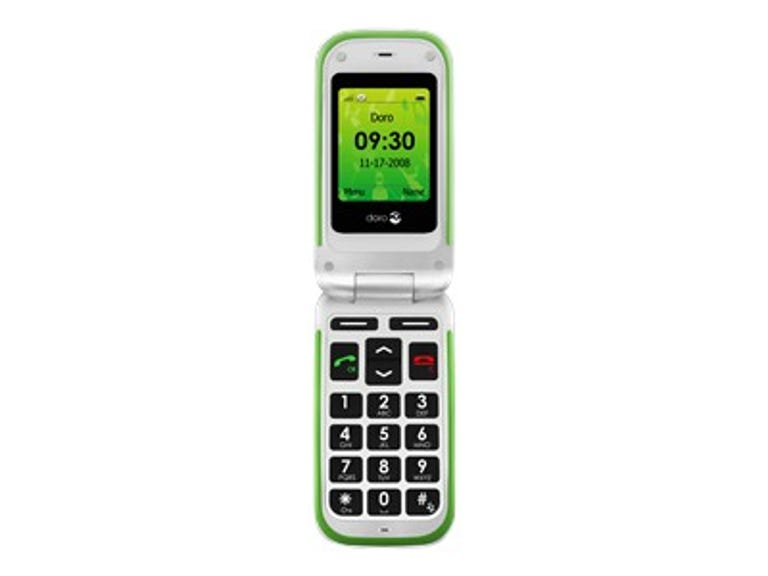We used to recommend the Samsung Jitterbug J as one of the best senior-friendly phones out there due to its ease of use and the fact that it comes with an array of operator services. However, the biggest complaint about the Jitterbug is the price: the phone is $147 up front and the service isn't cheap. Consumer Cellular, an MVNO that operates on the AT&T network, and which happens to be the exclusive wireless carrier for the American Association of Retired Persons (AARP) has offered a more affordable alternative. The company introduced two new handsets from Doro, a Swedish company that specializes in senior-friendly consumer electronics: the Doro PhoneEasy 345, a candy bar phone, and the Doro PhoneEasy 410, which has a clamshell design.
The Good
The Bad
The Bottom Line
The Doro PhoneEasy 410 has almost the same features as the PhoneEasy 345, except it doesn't have a flashlight. It is really easy to use, with big keys and a bright display with large fonts, a handy one-click emergency call button, and the bare basics of phone features. Even though it's billed as a phone for seniors, you do get slightly more advanced features like text messaging, Bluetooth, and an FM radio. And as we said, the phone is affordable. It's only $50 without any contract. Consumer Cellular rates range from $10 a month for no minutes to $60 a month for 2,000 minutes (additional minutes are 25 cents each). You won't get Jitterbug's array of operator services of course, but if you're a slightly savvier senior, you won't mind going without them, especially for the price.
Editor's note: Following the release of the PhoneEasy 410's subsequent model, the Doro PhoneEasy 618, we have lowered the score of this device in December 2012.
Design
The Doro PhoneEasy 410 has a very simple rectangular clamshell design. Measuring 3.85 inches long by 1.97 inches wide by 0.75 inch wide, the PhoneEasy 410 has a minimalist appeal with curved corners all around. It also won't weigh you down at only 3.9 ounces. The black version of the phone is coated in a soft touch covering, while the white version has a glossy reflective surface. There is a single green stripe on the front of the phone as a slight design detail.

Above the green stripe are two LEDs; one indicates the battery charging status, and the other flashes if you've received new text messages. We would've preferred an external display of some kind though, especially for caller ID and to quickly check the date or time. On the left spine of the phone is the volume rocker, while the charger and headset jack are on the right. On the back of the phone is the external speaker, plus a one-click emergency call button that will automatically dial five predetermined numbers on your emergency call list when pressed.

Flip open the phone and you'll find a very bright 2-inch display with 176x220-pixel support. It doesn't have the best resolution, but images and text still look sharp and we like the large display fonts. You can adjust the backlight time, the time and date format, whether to display the owner's phone number, and you have the choice of 14 languages as well. There is no font size setting, but the display font is already so large that this was OK with us. The menu style is the same as the one on the PhoneEasy 345; you just scroll up and down to navigate.

Underneath the display are two soft keys, a Talk button, two up-and-down arrow keys, the End/Power button, plus a very spacious number keypad. All the keys have a soft-touch rubbery feel and a nice give when pressed. We also like that the number keypad features large digits, and the keys are raised above the surface so it's easy to dial by feel.
Features
The Doro PhoneEasy 410 has similar features to the Doro PhoneEasy 345, so don't be surprised if you see some repeats here. It has a 100-entry phone book with room in each entry for just three phone numbers. You can't personalize a contact with a ringtone, but you do get 20 polyphonic ringtones with the phone. You can also add up to five contacts to your emergency call list.
Other basic features include a vibrate mode, voice mail, caller ID, nine speed dial memories, an alarm clock, a calendar, a calculator, plus an FM radio. The FM radio requires you to plug in a headset before it can work, though. The PhoneEasy 410 also has basic text messaging as well as Bluetooth. You can also deactivate the SMS function if you don't plan on using it.
Though it's not completely necessary, it's nice to see games on such a simple phone. It only comes with two--Robot and UFO--but they're fun enough. You can customize the display with one of eight included wallpaper backgrounds.
Performance
We tested the Doro PhoneEasy 410 in San Francisco using the Consumer Cellular network, which rides on top of the AT&T network. We saw full four-bar signal strength most of the time. We were highly impressed with the call quality as well. On our end, we heard our callers with plenty of volume and very little static or background noise.
Callers also reported similar call quality. They said our voices sounded clean, natural, and not at all harsh. We made a few calls to automated voice-response systems without any hiccups. Speakerphone calls sounded quite good as well, though callers said they heard a bit more echo and there was more background noise, but that's to be expected.
The Doro PhoneEasy 410 has a rated battery life of 4 hours talk time and a standby time of 11.7 days. Our tests showed a talk time of 4 hours and 45 minutes. According to the FCC, it has a digital SAR of 0.445 watt per kilogram.



